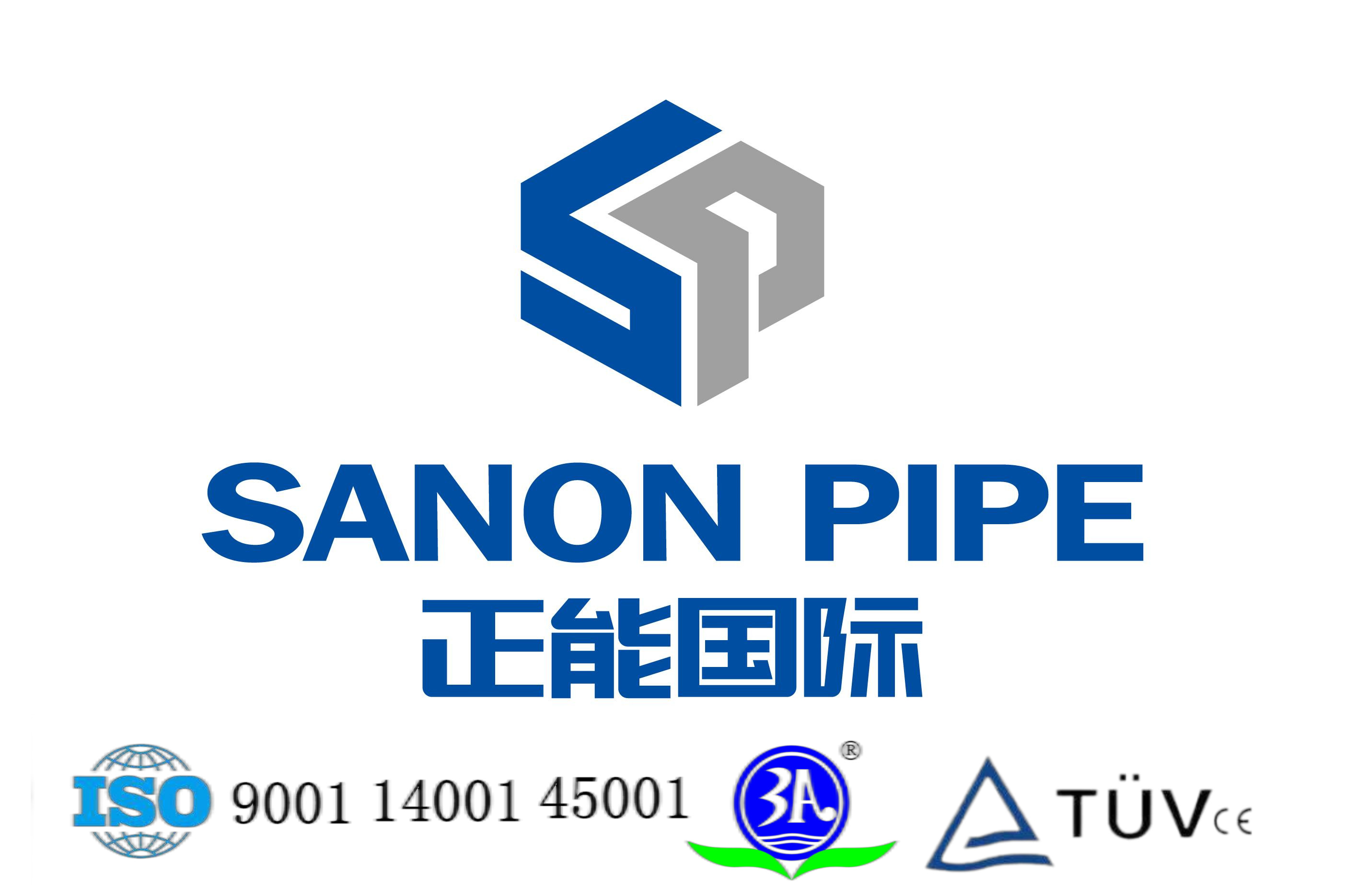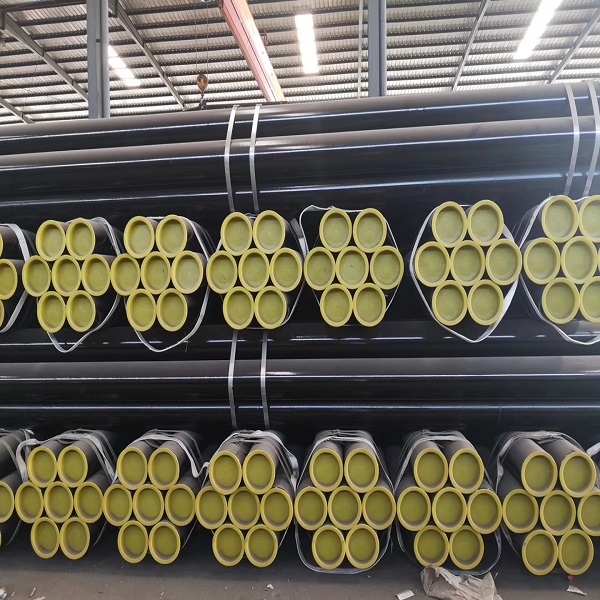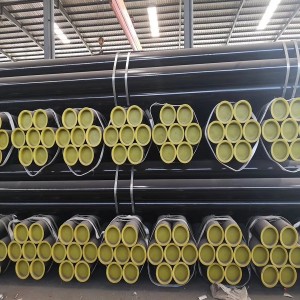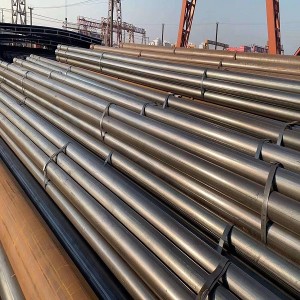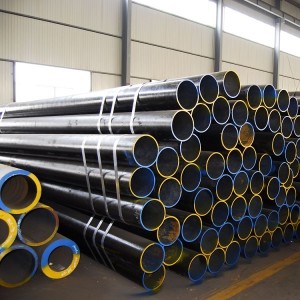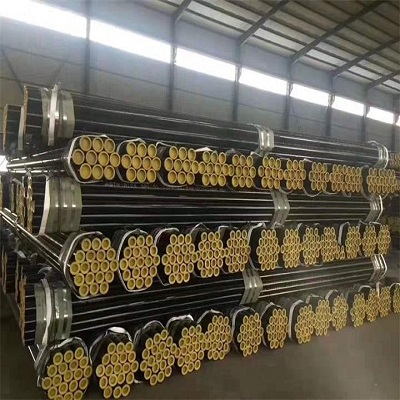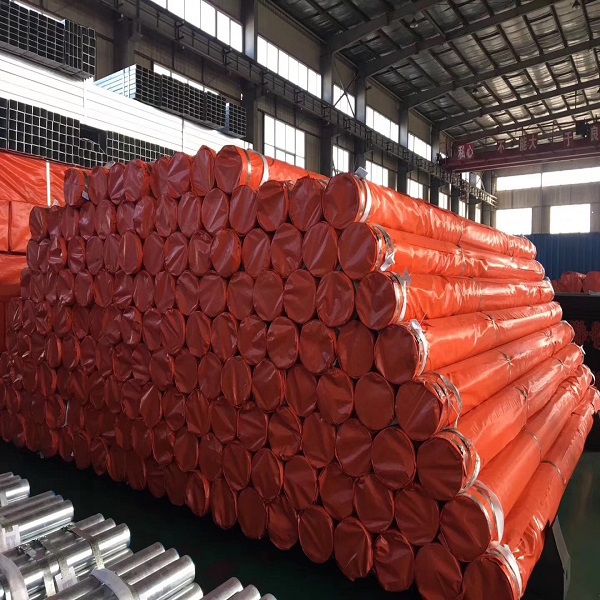High Quality China ASME/API/GOST/DIN/En/JIS Seamless and Welded Steel Pipe
Overview
All we do is usually linked with our tenet " Shopper first, Rely on very first, devoting around the food packaging and environmental safety for High Quality Seamless and Welded Steel Pipe, We put genuine and health as the primary responsibility. Now we have a professional international trade crew which graduated from America. We've been your next enterprise partner. Adhering to the principle of "Enterprising and Truth-Seeking, Preciseness and Unity", with technology as the core, our company continues to innovate, dedicated to providing you with the highest cost-effective products and meticulous after-sales service. We firmly believe that: we are outstanding as we are specialized.
Among the common structural seamless steel pipe materials, DIN1629 ST52 is one of the most commonly used materials. In Chinese standards, it usually corresponds to GB/T8162 Q345B. The two can be substituted for each other, but they are not completely corresponding. .
In terms of chemical composition:
DIN 1629 ST52: C: 0.17%max; P: 0.04%max; S:: 0.04%max; N: 0.009%max
GB/T 8162 Q345B: C: 0.2%max; P: 0.035%max; S:: 0.035%max; N: 0.012%max
It can be seen that the two standards jointly stipulate that the content of chemical elements is basically similar.
Mechanical performance:
DIN 1629 ST52: Tensile strength: 500~650Mpa; Yield strength: 335~355Mpa; Elongation (longitudinal): 21%min
GB/T 8162 Q345B: Tensile strength: 470~630Mpa; Yield strength: 295~345Mpa; Elongation (longitudinal): 20%min
The requirements for mechanical properties of the two are also roughly the same
Test items:
DIN 1629 requires tensile test, flattening test, tightness test, surface inspection, dimensional inspection; finished product analysis
GB/T8162 Q345B requires chemical composition inspection, tensile test, hardness test, 20℃ impact test, flattening test, bending test, non-destructive electrical test
It can be seen that the experimental project requirements of GB/T8162 Q345B basically cover DIN1629
Tolerance requirements:
DIN1629 stipulates:
OD tolerance:
OD≤100mm, ±1%or±0.5mm
100mm<OD≤200mm, ±1%
OD>200mm, ±1%
WT tolerance:
OD≤130mm: ≤2*standard WT: +15% -10%
2*standard WT<s≤4*standard WT:+12.5% -10%
>4*standard WT: ±9%
130mm<OD≤320mm:≤0.05*standard WT:+17% -12.5%
0.05*standard WT<s≤0.11*standard WT: ±12.5%
>0.11*standard WT: ±10%
320mm<OD≤660mm:≤0.05*standard WT: +20% -15%
0.05*standard WT<s≤0.09*standard WT: +15% -12.5%
>0.09*standard WT: +12.5% -10%
GB/T8162 stipulates:
OD tolerance:
±1% or ±0.5mm for the larger
WT tolerance:
OD≤102mm:±12.5% or ±0.4mm for the larger
OD>102mm:WT≤0.05mm, ±15% or ±0.4mm for the larger
0.05mm<WT≤0.1mm, ±12.5% or ±0.4mm for the larger
WT>0.1mm, +12.5% -10%
The tolerances of the two are also roughly the same
Therefore, Q345B and ST52 can be substituted for each other when used in a normal environment and there is no special requirement. When the environment or requirements are more stringent, the comparison needs to be carefully considered.
Application
It Is Mainly Used To Make Carbon Structural Steel, Alloy Structural Steel and mechanical structures.
Main Grade
Grade Of Carbon Structural Steel: 10,20,35, 45,Q345,Q460,Q490,Q620,, Etc
Grade Of Alloy Structural Steel: 42CrMo,35CrMo, Etc
Chemical Component
| Steel Grade |
Quality level |
Chemical composition |
||||||||||||||
|
C |
Si |
Mn |
P |
S |
Nb |
V |
Ti |
Cr |
Ni |
Cu |
Nd |
Mo |
B |
Als" |
||
|
no greater than |
not less than |
|||||||||||||||
| Q345 | A |
0.20 |
0.50 |
1.70 |
0.035 | 0.035 |
0.30 |
0.50 |
0.20 |
0.012 |
0.10 |
—— | — | |||
| B | 0.035 | 0.035 | ||||||||||||||
| C | 0.030 | 0.030 |
0.07 |
0.15 |
0.20 |
0.015 |
||||||||||
| D |
0.18 |
0.030 | 0.025 | |||||||||||||
| E | 0.025 | 0.020 | ||||||||||||||
| Q390 | A |
0.20 |
0.50 |
1.70 |
0.035 | 0.035 |
0.07 |
0.20 |
0.20 |
0.3 |
0.50 |
0.20 |
0.015 |
0.10 |
— | — |
| B | 0.035 | 0.035 | ||||||||||||||
| C | 0.030 | 0.030 |
0,015 |
|||||||||||||
| D | 0.030 | 0.025 | ||||||||||||||
| E | 0.025 | 0.020 | ||||||||||||||
| Q42O | A |
0.20 |
0.50 |
1.70 |
0.035 | 0.035 |
0.07 |
0.2 |
0.20 |
0.30 |
0.80 |
0.20 |
0.015 |
0.20 |
—— |
—— |
| B | 0.035 | 0.035 | ||||||||||||||
| C | 0.030 | 0.030 |
0.015 |
|||||||||||||
| D | 0.030 | 0.025 | ||||||||||||||
| E | 0.025 | 0.020 | ||||||||||||||
| Q46O | C |
0.20 |
0.60 |
1.80 |
0.030 | 0.030 |
0.11 |
0.20 |
0.20 |
0.30 |
0.80 |
0.20 |
0.015 |
0.20 |
0.005 |
0.015 |
| D | 0.030 | 0.025 | ||||||||||||||
| E | 0.025 | 0.020 | ||||||||||||||
| Q500 | C |
0J8 |
0.60 |
1.80 |
0.025 | 0.020 |
0.11 |
0.20 |
0.20 |
0.60 |
0.80 |
0.20 |
0.015 |
0.20 |
0.005 |
0.015 |
| D | 0.025 | 0.015 | ||||||||||||||
| E | 0.020 | 0.010 | ||||||||||||||
| Q550 | C |
0.18 |
0.60 |
2.00 |
0.025 | 0,020 | 0.11 |
0.20 |
0.20 |
0.80 |
0.80 |
0.20 |
0.015 |
0.30 |
0.005 |
0.015 |
| D | 0.025 | 0,015 | ||||||||||||||
| E | 0.020 | 0.010 | ||||||||||||||
| Q62O | C |
0.18 |
0.60 |
2.00 |
0.025 | 0.020 |
0.11 |
0.20 |
0.20 |
1.00 |
0.80 |
0.20 |
0.015 |
0.30 |
0.005 |
0.015 |
| D | 0.025 | 0.015 | ||||||||||||||
| E | 0.020 | 0.010 | ||||||||||||||
| a. In addition to Q345A and Q345B grades, the steel should contain at least one of the refined grain elements Al, Nb, V, and Ti. According to the needs, the supplier can add one or more refined grain elements. The maximum value shall be as specified in the table. When combined, Nb + V + Ti is not more than 0.22%b. For Q345, Q390, Q420 and Q46O grades, Mo + Cr is not greater than 0.30%c. When Cr and Ni of each grade are used as residual elements, the content of Cr and Ni should not be greater than 0.30%; when it is necessary to add, the content should meet the requirements in the table or be determined by the supplier and the buyer through consultation.d. If the supplier can ensure that the nitrogen content meets the requirements in the table, the nitrogen content analysis may not be performed. If Al, Nb, V, Ti and other alloy elements with nitrogen fixation are added to the steel, the nitrogen content is not limited. The nitrogen fixation content should be specified in the quality certificate.e. When using full aluminum, the total aluminum content Alt ≥ 0020%. | ||||||||||||||||
|
Grade |
Carbon equivalent CEV (mass fraction) /% |
|||||
|
Nominal wall thickness s≤ 16mm |
Nominal wall thickness S2>16 mm〜30 mm |
Nominal wall thickness S>30mm |
||||
|
Hot rolled or normalized normalized |
Quenching +tempering |
Hot rolled or normalized |
Quenching +tempering |
Hot rolled or normalized |
Quenching +tempering |
|
| Q345 |
<0.45 |
— |
<0.47 |
— |
<0.48 |
一 |
| Q390 |
<0.46 |
一 |
W0.48 |
— |
<0.49 |
— |
| Q420 |
<0.48 |
一 |
<0.50 |
<0.48 |
<0.52 |
<0,48 |
| Q460 |
<0.53 |
<0.48 |
W0.55 |
<0.50 |
<0.55 |
W0.50 |
| Q500 |
一 |
<0.48 |
一 |
<0.50 |
一 |
W0.50 |
| Q550 |
— |
<0.48 |
.一 |
<0.50 |
一 |
<0.50 |
| Q62O |
— |
<0.50 |
— |
<0.52 |
— |
W0.52 |
| Q690 |
— |
<0.50 |
— |
<0.52 |
— |
W0.52 |
Mechanical Property
Mechanical properties of high-quality carbon steel structural steel and low-alloy high-strength structural steel pipes
| Grade | Quality level | Yield Strength | Lower yield strength | Elongation after breaking | Impact test | |||
| Nominal wall thickness | temperature | Absorb energy | ||||||
| <16 mm | >16 mm〜 | 〉30 mm | ||||||
| 30 mm | ||||||||
| not less than | not less than | |||||||
| 10 | — | >335 | 205 | 195 | 185 | 24 | — | — |
| 15 | — | >375 | 225 | 215 | 205 | 22 | — | 一 |
| 20 | —— | >410 | 245 | 235 | 225 | 20 | — | — |
| 25 | — | >450 | 275 | 265 | 255 | 18 | — | — |
| 35 | — | >510 | 305 | 295 | 285 | 17 | 一 | — |
| 45 | — | 2590 | 335 | 325 | 315 | 14 | — | — |
| 20Mn | —• | >450 | 275 | 265 | 255 | 20 | — | 一 |
| 25Mn | — | >490 | 295 | 285 | 275 | 18 | — | — |
| Q345 | A | 470—630 | 345 | 325 | 295 | 20 | — | 一 |
| B | 4~20 | 34 | ||||||
| C | 21 | 0 | ||||||
| D | -20 | |||||||
| E | -40 | 27 | ||||||
| Q39O | A | 490—650 | 390 | 370 | 350 | 18 | ||
| B | 20 | 34 | ||||||
| C | 19 | 0 | ||||||
| D | -20 | |||||||
| E | -40 | 27 | ||||||
| Q42O | A | 520〜680 | 420 | 400 | 380 | 18 | ||
| B | 20 | 34 | ||||||
| C | 19 | 0 | ||||||
| D | -20 | |||||||
| E | -40 | 27 | ||||||
| Q46O | C | 550〜720 | 460 | 440 | 420 | 17 | 0 | 34 |
| D | -20 | |||||||
| E | -40 | 27 | ||||||
| Q500 | C | 610〜770 | 500 | 480 | 440 | 17 | 0 | 55 |
| D | -20 | 47 | ||||||
| E | -40 | 31 | ||||||
| Q550 | C | 670〜830 | 550 | 530 | 490 | 16 | 0 | 55 |
| D | -20 | 47 | ||||||
| E | -40 | 31 | ||||||
| Q62O | C | 710〜880 | 620 | 590 | 550 | 15 | 0 | 55 |
| D | -20 | 47 | ||||||
| E | -40 | 31 | ||||||
| Q690 | C | 770〜94。 | 690 | 660 | 620 | 14 | 0 | 55 |
| D | -20 | 47 | ||||||
| E | -40 | 31 | ||||||
Mechanical properties of alloy steel pipes
| NO | Grade | Recommended heat treatment regime | Tensile properties | Annealed or high temperature tempered steel pipe Delivery condition Brinell hardness HBW | ||||||
| Quenching (normalizing) | Tempering | Yield StrengthMPa | Tensile Strength MPa | Elongation after breaking A% | ||||||
| temperature | Coolant | Temperature | Coolant | |||||||
| Frirst | Second | not less than | no greater than | |||||||
| 1 | 40Mn2 | 840 | Water, oil | 540 | Water, oil | 885 | 735 | 12 | 217 | |
| 2 | 45Mn2 | 840 | Water,oil | 550 | Water, oil | 885 | 735 | 10 | 217 | |
| 3 | 27SiMn | 920 | Water | 450 | Water, oil | 980 | 835 | 12 | 217 | |
| 4 | 40MnBc | 850 | oil | 500 | Water, oil | 980 | 785 | 10 | 207 | |
| 5 | 45MnBc | 840 | oil | 500 | Water, oil | 1 030 | 835 | 9 | 217 | |
| 6 | 20Mn2Bc'f | 880 | oil | 200 | Water, air | 980 | 785 | 10 | 187 | |
| 7 | 20CrdJ | 880 | 800 | Water,oil | 200 | Water, air | 835 | 540 | 10 | 179 |
| 785 | 490 | 10 | 179 | |||||||
| 8 | 30Cr | 860 | oil | 500 | Water, oil | 885 | 685 | 11 | 187 | |
| 9 | 35Cr | 860 | oil | 500 | Water, oil | 930 | 735 | 11 | 207 | |
| 10 | 40Cr | 850 | oil | 520 | Water, oil | 980 | 785 | 9 | 207 | |
| 11 | 45Cr | 840 | oil | 520 | Water, oil | 1 030 | 835 | 9 | 217 | |
| 12 | 50Cr | 830 | oil | 520 | Water, oil | 1 080 | 930 | 9 | 229 | |
| 13 | 38CrSi | 900 | oil | 600 | Water, oil | 980 | 835 | 12 | 255 | |
| 14 | 20CrModJ | 880 | Water,oil | 500 | Water, oil | 885 | 685 | 11 | 197 | |
| 845 | 635 | 12 | 197 | |||||||
| 15 | 35CrMo | 850 | oil | 550 | Water, oil | 980 | 835 | 12 | 229 | |
| 16 | 42CrMo | 850 | oil | 560 | Water, oil | 1 080 | 930 | 12 | 217 | |
| 17 | 38CrMoAld | 940 | Water, oil | 640 | Water, oil | 980 | 835 | 12 | 229 | |
| 930 | 785 | 14 | 229 | |||||||
| 18 | 50CrVA | 860 | oil | 500 | Water, oil | 1 275 | 1 130 | 10 | 255 | |
| 19 | 2OCrMn | 850 | oil | 200 | Water、air | 930 | 735 | 10 | 187 | |
| 20 | 20CrMnSif | 880 | oil | 480 | Water, oil | 785 | 635 | 12 | 207 | |
| 21 | 3OCrMnSif | 880 | oil | 520 | Water, oil | 1 080 | 885 | 8 | 229 | |
| 980 | 835 | 10 | 229 | |||||||
| 22 | 35CrMnSiA£ | 880 | oil | 230 | Water、air | 1 620 | 9 | 229 | ||
| 23 | 20CrMnTie-f | 880 | 870 | oil | 200 | Water、air | 1 080 | 835 | 10 | 217 |
| 24 | 30CrMnTie*f | 880 | 850 | oil | 200 | Water、air | 1 470 | 9 | 229 | |
| 25 | 12CrNi2 | 860 | 780 | Water,oil | 200 | Water、air | 785 | 590 | 12 | 207 |
| 26 | 12CrNi3 | 860 | 780 | oil | 200 | Water、air | 930 | 685 | 11 | 217 |
| 27 | 12Cr2Ni4 | 860 | 780 | oil | 200 | Water、air | 1 080 | 835 | 10 | 269 |
| 28 | 40CrNiMoA | 850 | —— | oil | 600 | Water、air | 980 | 835 | 12 | 269 |
| 29 | 45CrNiMoVA | 860 | — | oil | 460 | oil | 1 470 | 1 325 | 7 | 269 |
| a. Allowable adjustment range of heat treatment temperature listed in the table: quenching ± 15 ℃, low temperature tempering ± 20 ℃, high temperature tempering soil 50 ℃.b. In the tensile test, transverse or longitudinal samples can be taken. In case of disagreement, the longitudinal sample is used as the basis for arbitration.c. Boron-containing steel can be normalized before quenching, and the normalizing temperature should not be higher than its quenching temperature.d. Delivery according to a set of data specified by the demander. When the demander has not specified, delivery can be made according to any of the data.e. The first quenching of titanium steel with Ming Meng can be replaced by normalizing.
f. Isothermal quenching at 280 C ~320 C. g. In the tensile test, if Rel cannot be measured, Rp0.2 can be measured instead of Rel. |
||||||||||
Test Requirement
Chemical composition:
Stretch,Hardness,Shock,Squash,Bending,Ultrasonic testing,Eddy current,detection,Leak detection,Galvanized
